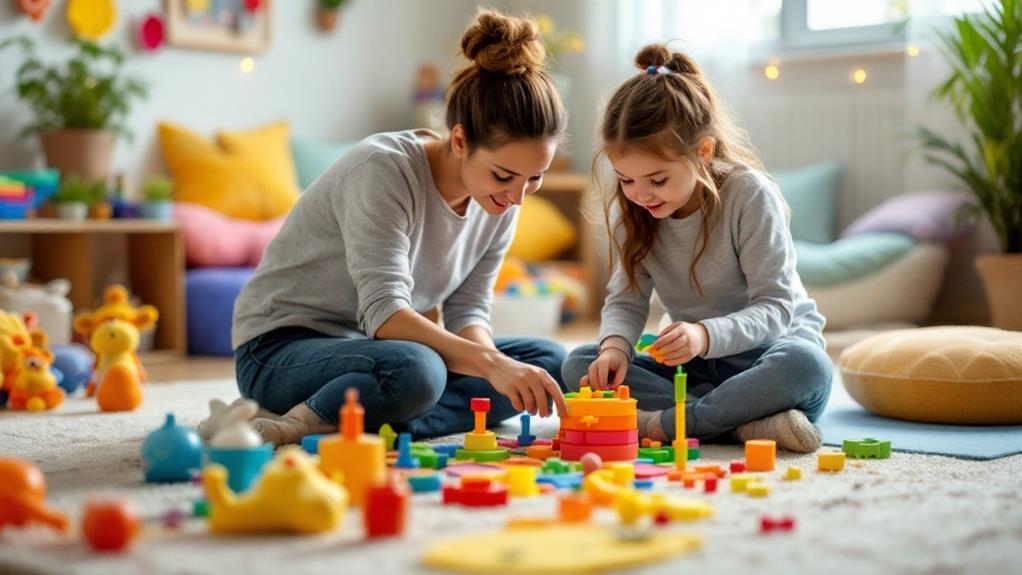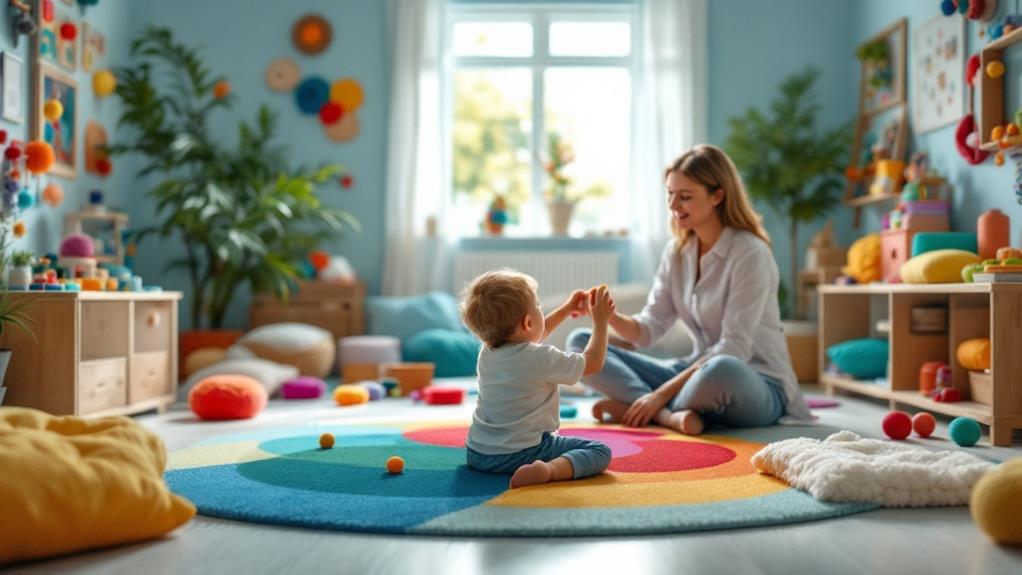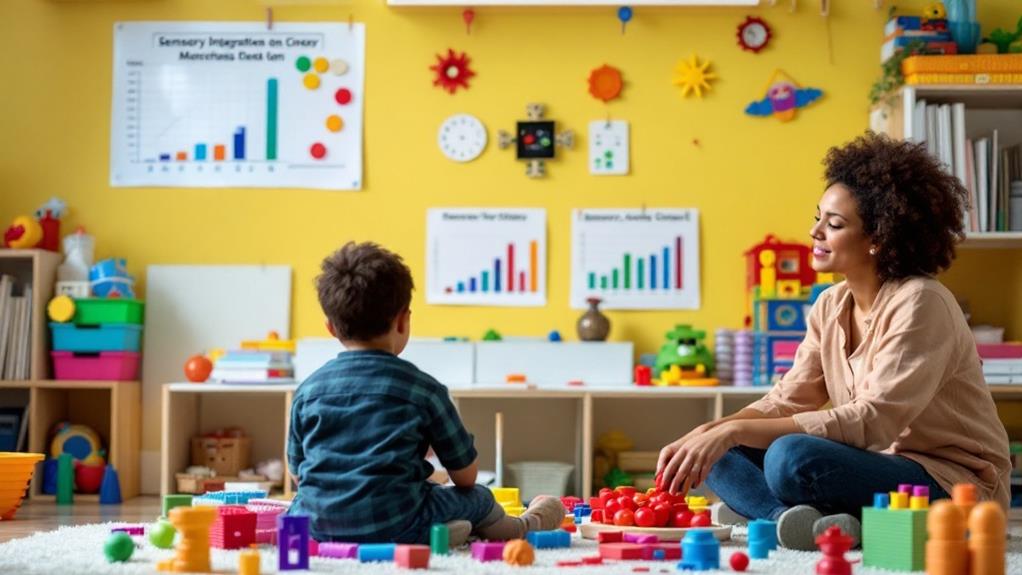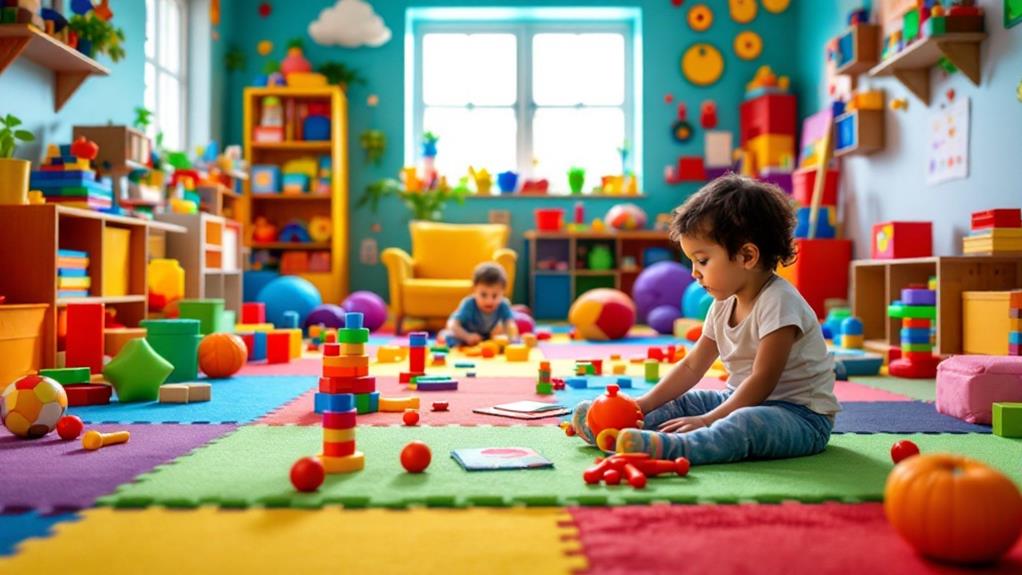In ABA therapy, sensory integration is essential for helping you or your child effectively process sensory information. It addresses sensory processing challenges by creating tailored interventions that align with individual needs. You might engage in activities that enhance focus, like tactile play or calming music, which help regulate emotions and behaviors. Individualized sensory assessments also play a role here, ensuring that therapy sessions are designed with personal sensitivities in mind. By collaborating with occupational therapists, the approach becomes more holistic, promoting better engagement and progress. Discovering how these methods work together can uncover even more effective strategies.
Essential Takeaways for Effective Sensory Integration in ABA Therapy
- Sensory integration is recognized in ABA therapy to enhance engagement and appropriate responses to environmental stimuli.
- Individualized sensory assessments identify specific sensitivities and triggers, guiding tailored interventions.
- Collaboration with occupational therapists provides insights on sensory processing, improving intervention strategies.
- Creating sensory-friendly environments reduces anxiety and enhances focus during therapy sessions.
- Incorporating sensory breaks and tools supports self-regulation and promotes comfort, improving overall therapeutic outcomes.
Understanding Sensory Integration

Understanding sensory integration is essential for anyone involved in Applied Behavior Analysis (ABA) therapy. It's all about how we process and respond to sensory information from our environment. When you think about sensory integration, consider how your own senses—sight, sound, touch, taste, and smell—work together to help you navigate daily life.
For individuals with sensory integration challenges, this process can be disrupted, affecting their ability to respond appropriately to stimuli.
In your role, recognizing the significance of sensory integration allows you to create a supportive environment. You'll want to pay attention to how different sensory inputs influence behavior. For instance, a loud noise might overwhelm someone, causing anxiety or agitation. By understanding these dynamics, you can tailor interventions that promote positive sensory experiences, enhancing engagement and learning.
Moreover, collaborating with other professionals—like occupational therapists—can deepen your understanding of sensory needs. Together, you can implement strategies that foster a sense of safety and comfort.
Ultimately, your awareness of sensory integration equips you to serve others more effectively, guiding them toward greater emotional and behavioral regulation.
Sensory Processing Challenges
Many individuals experience sensory processing challenges that can greatly impact their daily lives. These challenges might manifest as heightened sensitivity to sounds, textures, or lights, making everyday situations overwhelming. You may notice someone struggling in crowded places or avoiding certain fabrics because they feel uncomfortable.
It's crucial to understand that these reactions aren't just quirks; they often stem from how the brain processes sensory information.
In therapy, recognizing these challenges is the first step toward helping individuals navigate their world more comfortably. You can work with a therapist to identify specific triggers and develop strategies to cope with them. For instance, using noise-canceling headphones in loud environments can provide relief, while introducing calming sensory tools, like weighted blankets or fidget toys, can offer comfort.
Addressing sensory processing challenges isn't just about managing discomfort; it's about empowering individuals to engage more fully in their lives. By fostering an understanding of these challenges, you can create supportive environments that validate experiences and promote growth.
The Importance of ABA Therapy

ABA therapy, or Applied Behavior Analysis, is a powerful tool that can transform the lives of individuals facing various challenges, particularly those with autism spectrum disorder. By focusing on observable behavior and the principles of learning, ABA therapy helps individuals develop essential skills, improve communication, and reduce problematic behaviors.
When you engage in ABA therapy, you're not just addressing surface-level issues; you're diving deep into understanding the root causes of behavior. This approach allows practitioners to create tailored interventions that meet the unique needs of each individual.
Whether it's teaching social skills, self-care routines, or academic tasks, ABA therapy equips individuals with the tools they need to thrive in everyday situations.
Furthermore, ABA therapy emphasizes data-driven decision-making. You'll see measurable progress, providing both the therapist and the individual with tangible evidence of growth.
This focus on evidence not only fosters trust but also empowers families to be active participants in their loved ones' journeys. By valuing each individual's potential and fostering a supportive environment, ABA therapy helps create pathways toward greater independence and quality of life.
Your commitment to this process can make a significant difference in someone's world.
Techniques for Sensory Engagement
When it comes to enhancing sensory engagement in therapy, incorporating a variety of techniques can make a significant difference. Start by using tactile activities, like playdough or textured materials, to help individuals explore different sensations. These hands-on experiences can promote both focus and enjoyment.
Visual engagement is equally important. Use colorful visuals or light-up toys to capture attention and stimulate curiosity. You can create a visually rich environment that encourages exploration and learning.
Auditory techniques, such as playing calming music or using rhythmic sounds, can also help. These sounds can create a soothing atmosphere, promoting relaxation during therapy sessions.
Don't overlook movement! Incorporate activities that involve swinging, bouncing, or spinning. These motions can provide essential vestibular input, helping individuals regulate their sensory systems.
Try integrating deep pressure techniques, like squeezing a stress ball or using weighted blankets, which can be grounding and comforting.
Individualized Sensory Assessments

Understanding each individual's unique sensory preferences and challenges is essential for effective therapy. When you conduct individualized sensory assessments, you can gather critical insights that shape your approach.
Start by observing how the individual interacts with their environment. Are they drawn to certain textures, sounds, or movements? Note their responses—both positive and negative—to different stimuli.
Next, engage in discussions with caregivers, teachers, or anyone involved in the individual's life. They can provide valuable information about sensory experiences outside of therapy sessions. This collaboration helps paint a complete picture of the individual's sensory profile.
Utilizing standardized assessment tools can also be beneficial. These tools can help quantify sensory sensitivities and preferences, making it easier to identify patterns.
After gathering this information, tailor your therapy sessions to incorporate sensory activities that align with the individual's needs and preferences.
Behavioral Interventions and Sensory Needs
Addressing sensory needs is essential for implementing effective behavioral interventions. When you understand a child's unique sensory profile, you can tailor your approach to meet their specific needs. For instance, if a child is particularly sensitive to loud noises, you might create a quieter environment or use noise-canceling headphones during therapy sessions. This helps them focus better and engage more fully in the interventions designed to improve their behavior.
Incorporating sensory breaks into your sessions can also be a game-changer. These breaks allow children to engage in sensory activities that help them self-regulate. Whether it's squeezing a stress ball, jumping on a trampoline, or engaging in deep pressure activities, these breaks can greatly enhance their readiness to learn and participate.
Moreover, using visual supports and structured routines can help children with sensory sensitivities feel more secure. Predictability can reduce anxiety and create a safe space for them to thrive.
Collaboration With Occupational Therapists

Collaborating with occupational therapists can greatly enhance the effectiveness of ABA therapy, especially when it comes to addressing sensory integration. When you work together with these professionals, you can create a more holistic approach that meets the unique sensory needs of each individual.
Occupational therapists bring valuable insights into sensory processing, helping you understand how specific stimuli affect behavior and learning. By combining your expertise in behavior analysis with their knowledge of sensory strategies, you can develop tailored interventions that promote engagement and reduce anxiety.
For instance, if a child struggles with overwhelming noises, the occupational therapist can recommend specific techniques to help them cope, which you can then incorporate into your ABA sessions.
Moreover, this collaboration fosters a consistent environment for the individual. When everyone involved is on the same page, it reinforces learning and helps the individual feel more secure.
Sharing progress and challenges with the occupational therapist guarantees that you can adjust strategies in real-time, enhancing the overall effectiveness of therapy. Ultimately, this partnership not only benefits the individual but also enriches your professional practice, empowering you to make a meaningful impact in their lives.
Creating Sensory-Friendly Environments
Creating sensory-friendly environments can greatly enhance the effectiveness of ABA therapy by reducing overwhelming stimuli that may hinder learning and engagement.
You'll want to assess the space where therapy takes place, ensuring it's calm and inviting. Start by minimizing bright lights and loud noises. Soft, natural lighting and soundproofing can make a world of difference.
Incorporate sensory tools that cater to individual needs. Consider using textured materials, weighted blankets, or fidget toys. These items can provide comfort and help maintain focus during sessions.
Designate a quiet corner with calming visuals where your client can take breaks if they start to feel overwhelmed.
It's also essential to be mindful of scents. Strong odors can distract or discomfort some individuals, so opting for neutral scents can create a more pleasant atmosphere.
Evaluating Progress in Therapy

Evaluating progress in therapy is essential for guaranteeing that your client is moving toward their goals and benefiting from the interventions provided. You'll want to use a combination of qualitative and quantitative measures to get a holistic view of their development. Regularly collect data on specific skills you're targeting, such as communication, social interactions, or sensory processing abilities. This data will help you identify trends and adjustments needed in your approach.
Additionally, consider gathering feedback from parents, caregivers, and even the clients themselves. Their insights can reveal how your interventions impact daily life beyond the therapy setting.
Don't forget to celebrate small victories; these moments can greatly motivate both you and your client.
Regularly review goals and modify them based on progress. If certain strategies aren't effective, be open to exploring alternative methods. Remember, progress isn't always linear—there will be ups and downs. Your adaptability and responsiveness to these changes are vital.
Conclusion
Incorporating sensory integration into ABA therapy enriches your approach, fosters connections, and enhances engagement. By understanding sensory processing challenges, utilizing tailored techniques, and collaborating with occupational therapists, you create a supportive environment that meets individual needs. As you evaluate progress and adjust interventions, you'll not only help clients thrive but also empower them to navigate their world more confidently. Embracing this holistic method transforms therapy into a dynamic journey towards growth, understanding, and empowerment.

